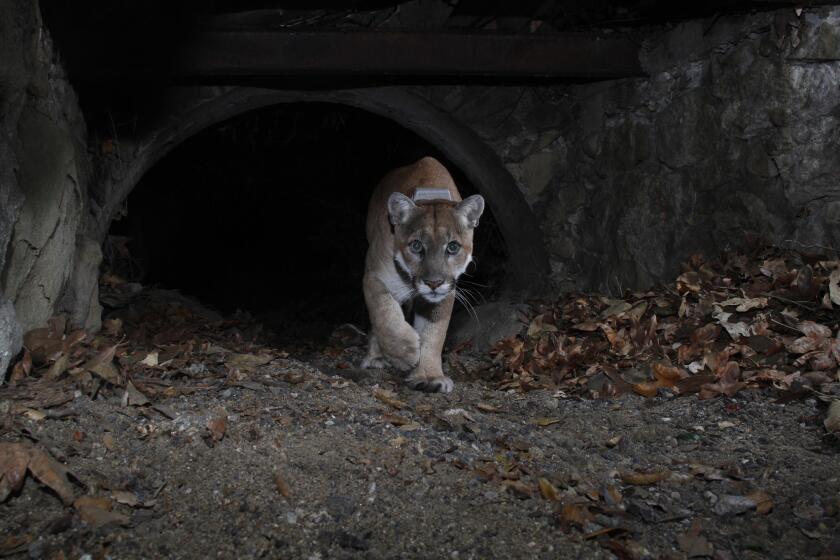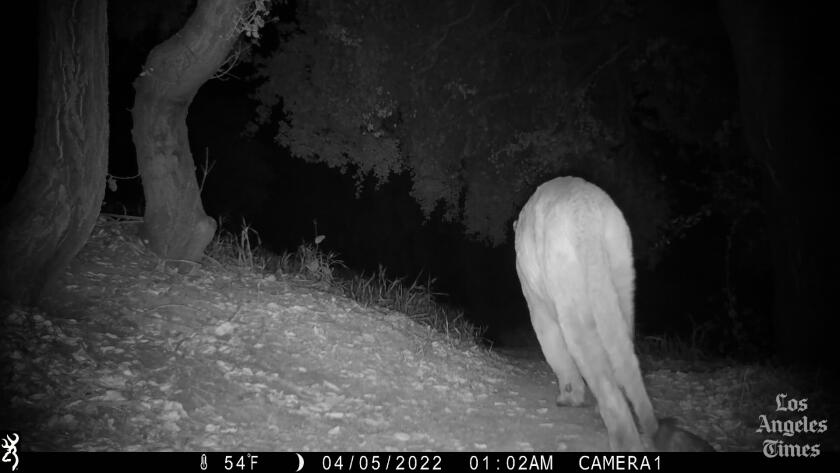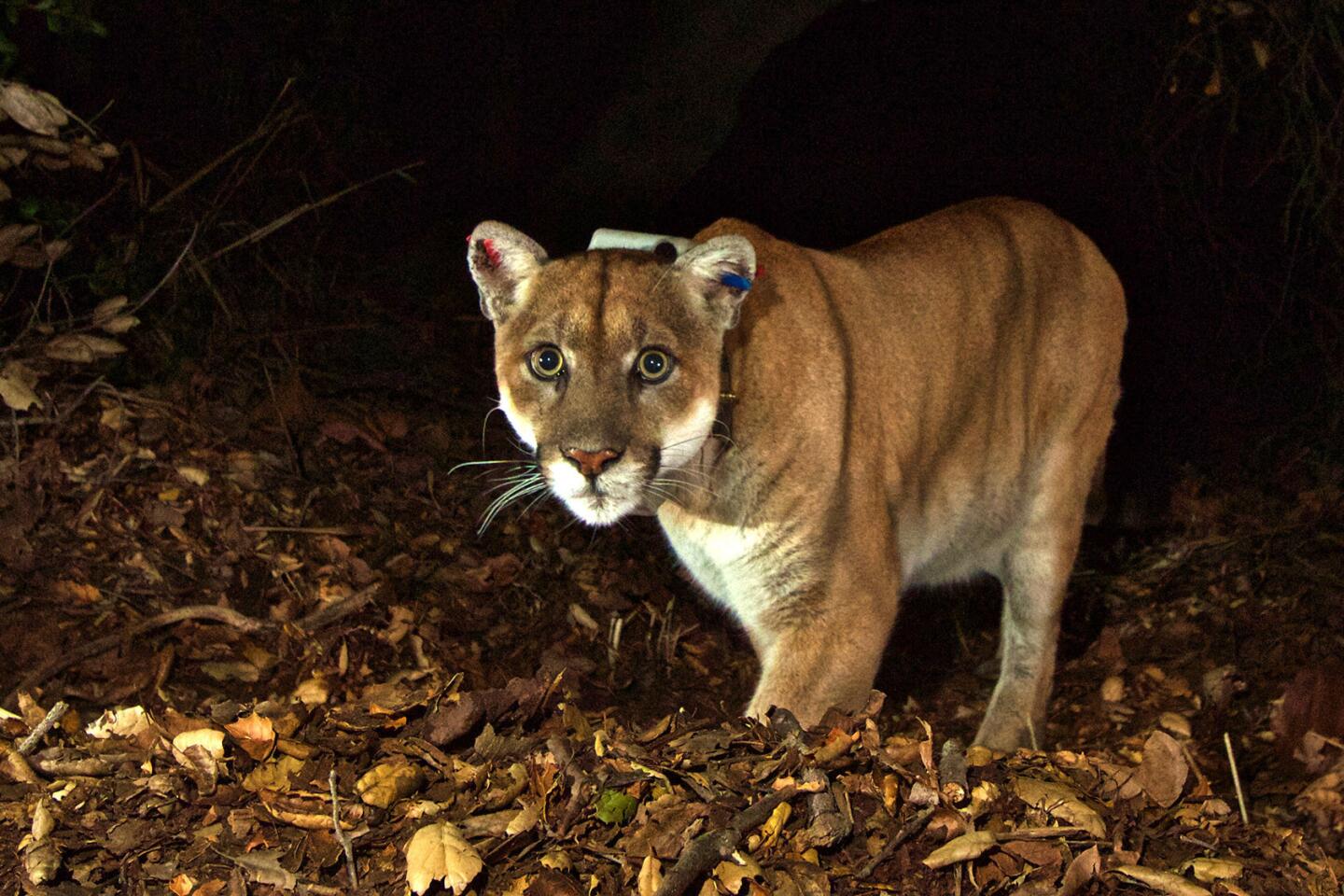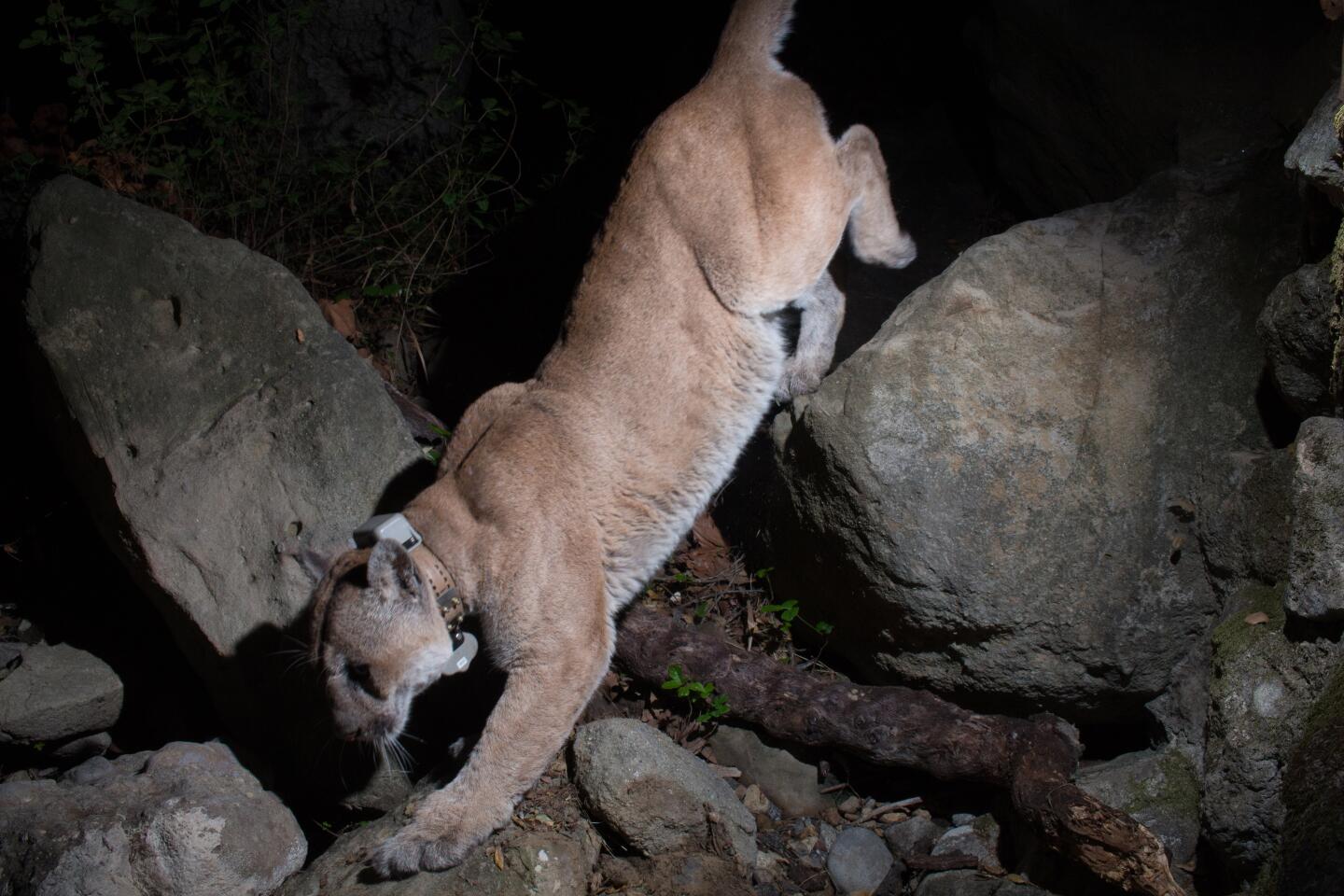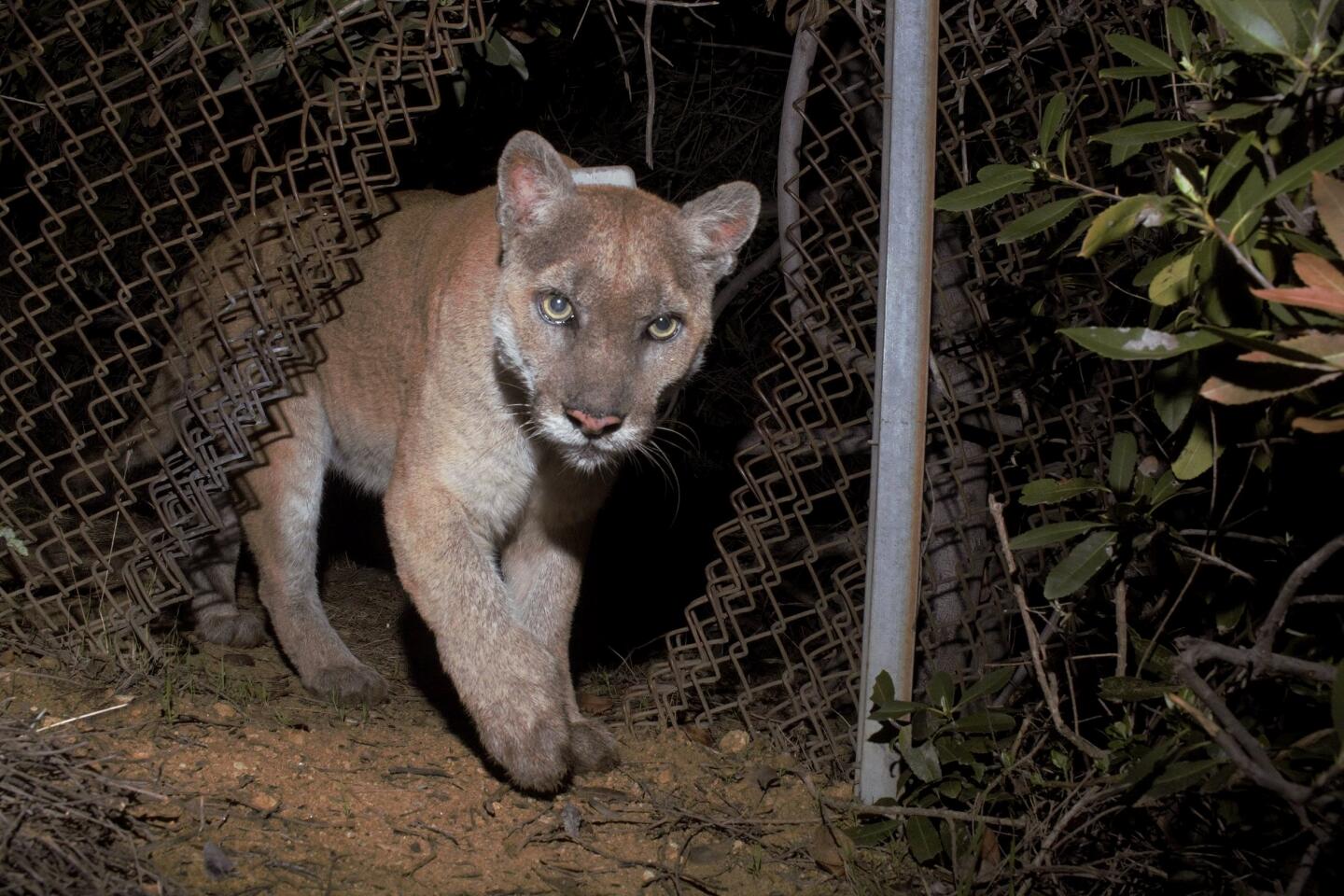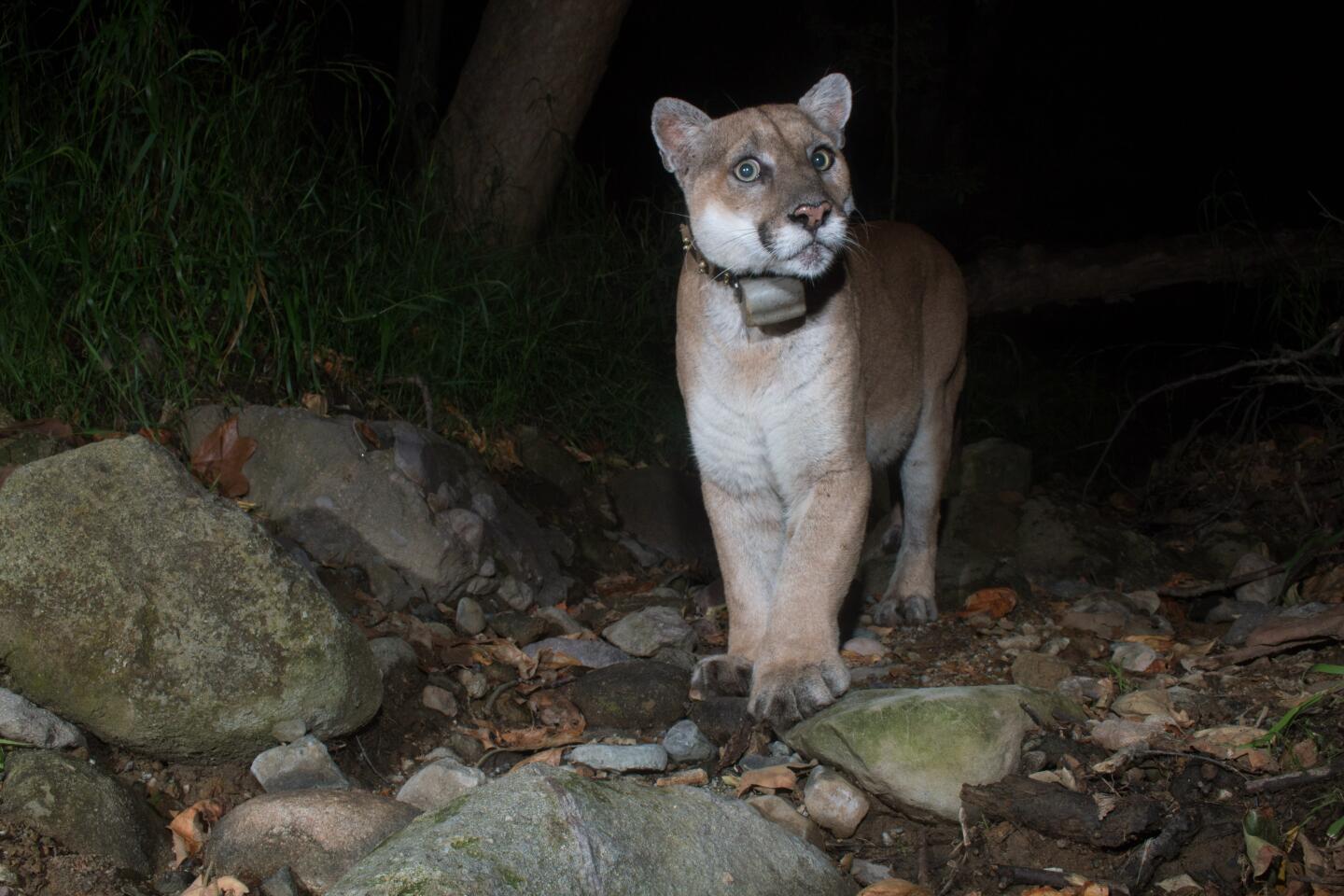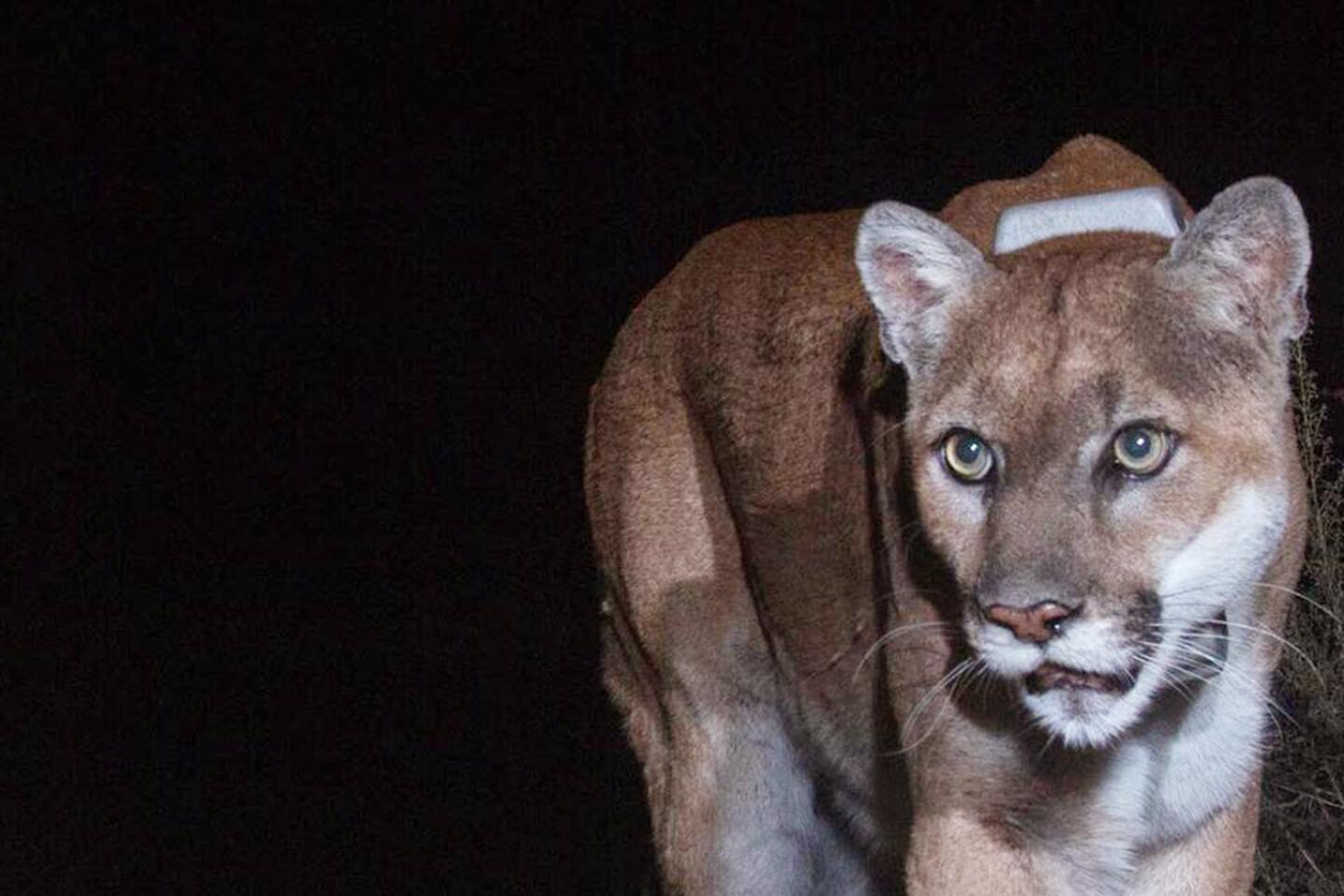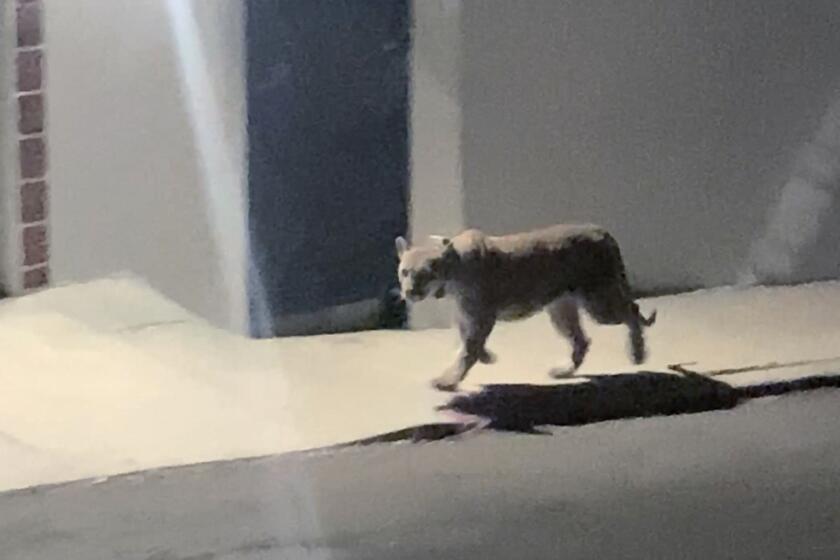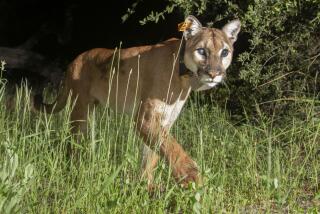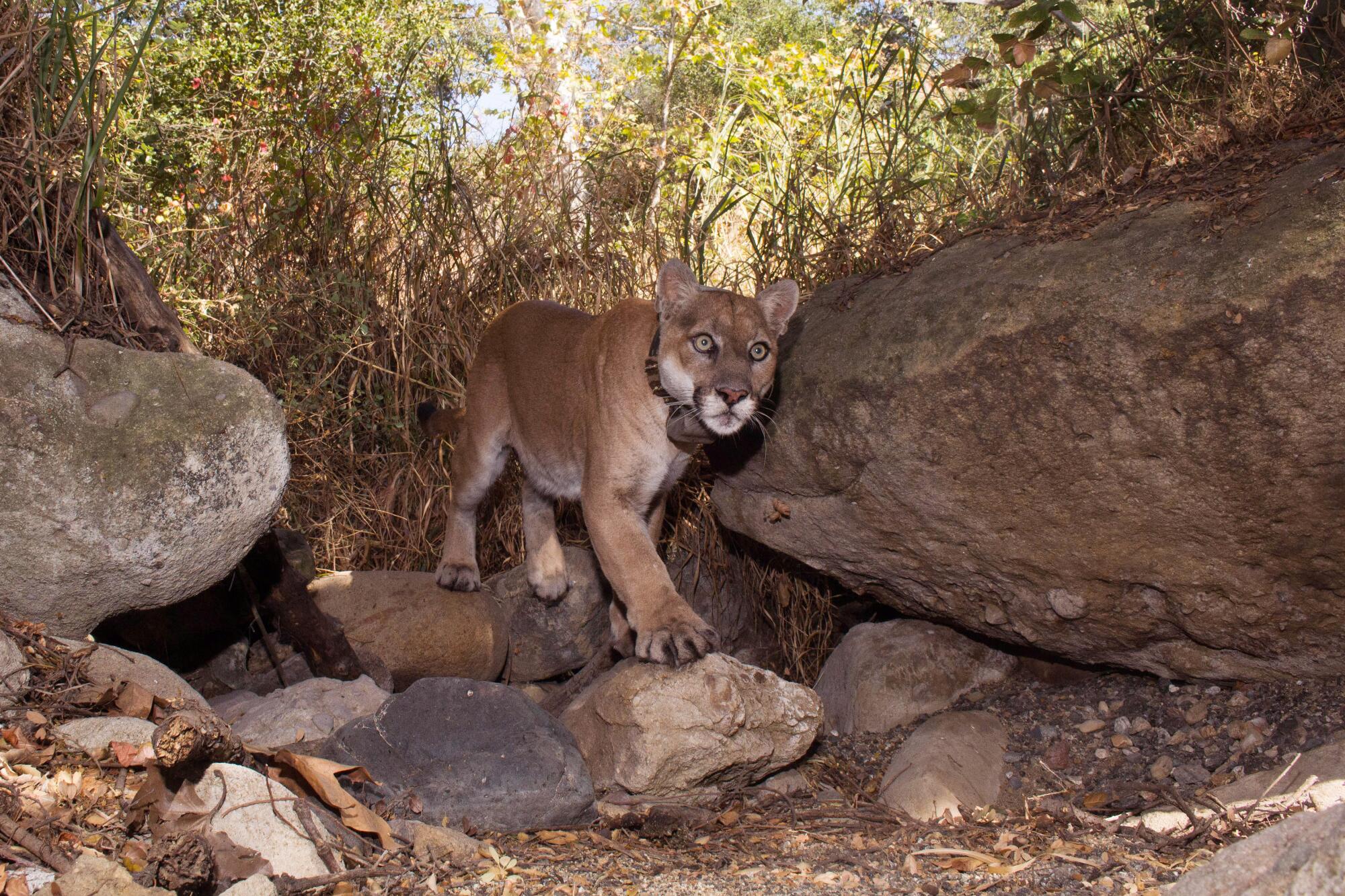
Not long after Michael McMahan moved to the Cahuenga Pass, a friendly hiker in Griffith Park warned him to watch out for mountain lions.
Was that a joke? McMahan wondered. He went home and Googled it. And there the animal was, in a photo made famous in 2013 in National Geographic: tawny, sinewy, prowling below the Hollywood sign.
A few years later, McMahan started installing his own motion-activated cameras on canyons and trails. Nine months later, he got his first video of the puma. Grainy, black-and-white, but unmistakably the same cat. He’s recorded him 75 times since — twice this month alone — making him one of the most prolific chroniclers of the urban mountain lion known as P-22.
“P-22 and I, we’re at similar stages in our lives: We’re just two older bachelors roaming the Hollywood Hills,” said McMahan, 58, who has the puma’s face tattooed on his left shoulder. “He’s got this air of mystery to him. You never know when he’s going to show up.”
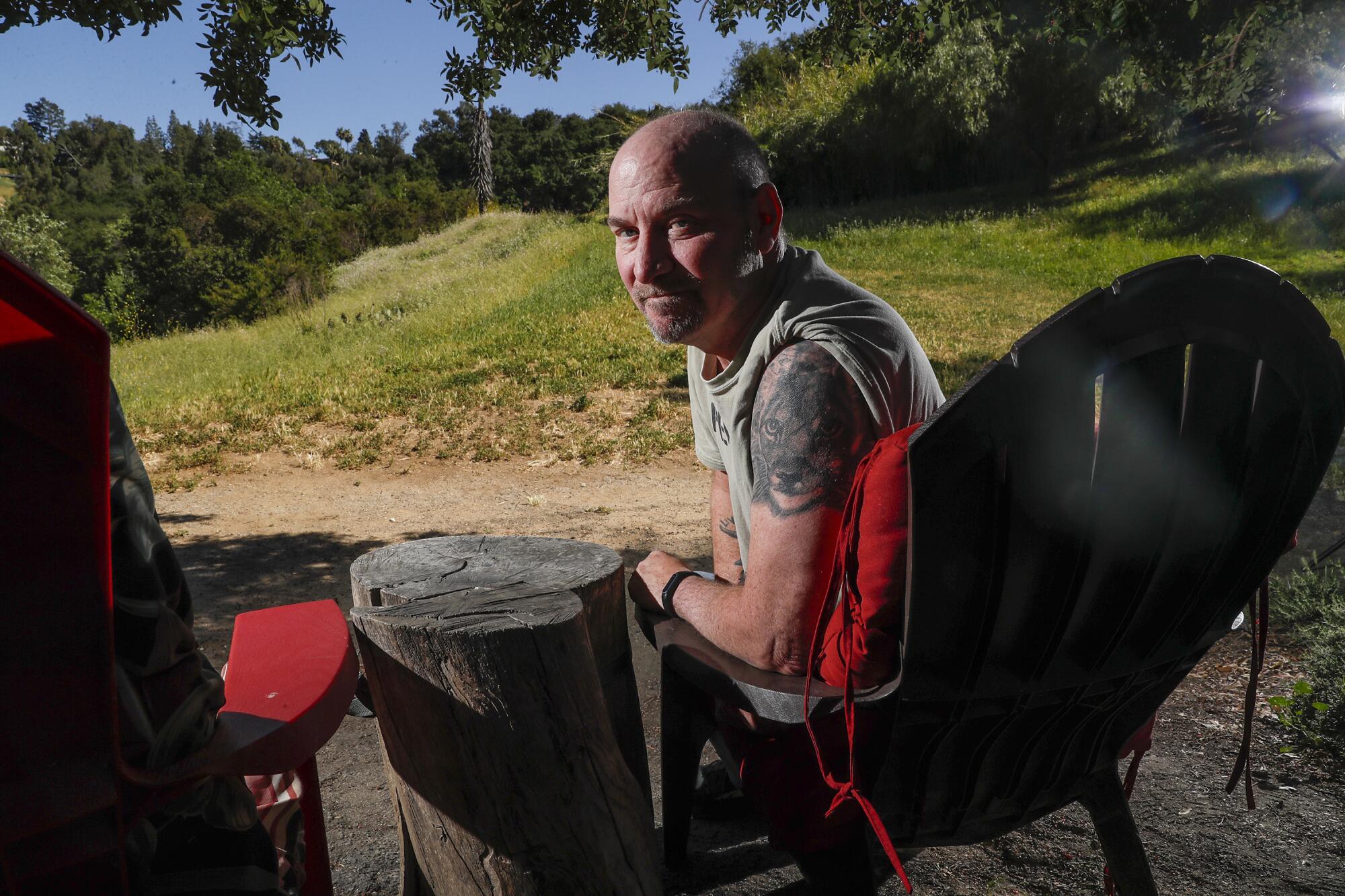
It has been a decade since P-22 surprised the world by appearing in Griffith Park, which scientists had considered too small and too surrounded by freeways to support an apex predator. To reach Los Feliz from his likely birthplace in the Santa Monica Mountains, the cougar would have made an improbable journey through the Hollywood Hills, crossing the 405 and 101 freeways.
Scientists assumed P-22 would eventually leave Griffith Park to find a mate or a bigger territory. Most male pumas in the Santa Monica Mountains have about 150 square miles to roam; P-22’s territory is about 6% that size. But, it seemed, he knew prime real estate when he saw it.
He has stayed in the heart of Los Angeles for 10 years, eating mule deer and raccoons, slinking through hillside neighborhoods, causing the occasional media frenzy by lodging himself under a house or killing a koala at the zoo. Those escapades, plus his photogenic face, have helped turn P-22 into the world’s most famous and beloved mountain lion.
In addition to his glossy spread in National Geographic, P-22 is the star of a documentary and the subject of a Natural History Museum exhibit. By order of the City Council, every Oct. 22 in Los Angeles is “P-22 Day.” His face has adorned coloring books, bumper stickers and a tacky Christmas sweater.
Scientists caution against anthropomorphizing P-22, but Angelenos can’t help but see themselves in the big cat. He battled traffic on the 405 and never wanted to do it again. He’s carved out a life in a crowded city. And though he’s still handsome for his advanced age — most pumas in the wild don’t live past 12, and he’s already there — he’s terminally single.
“I like to call him the Brad Pitt of the cougar world,” said Beth Pratt, a regional executive director in California for the National Wildlife Federation, who calls herself P-22’s agent. (That comparison is slightly unfair to Pitt, who has been married twice and has six children. As far as scientists know, P-22 has never mated.)
Michael McMahan’s remote trail camera captured P-22 out for a late-night stroll in early April, the sound from traffic on the 101 Freeway audible in the background.
The first glimpse of P-22 was his backside. Miguel Ordeñana, then a 29-year-old wildlife biologist, was reviewing photos from a motion-activated camera in Griffith Park when he glimpsed a “big puma butt” with velvety haunches and an unmistakable black-tipped tail.
Ordeñana couldn’t believe his eyes. The 2012 discovery, he said, was like “seeing Bigfoot or a chupacabra.” He sprinted two blocks to his car to retrieve his cellphone and call his partners.
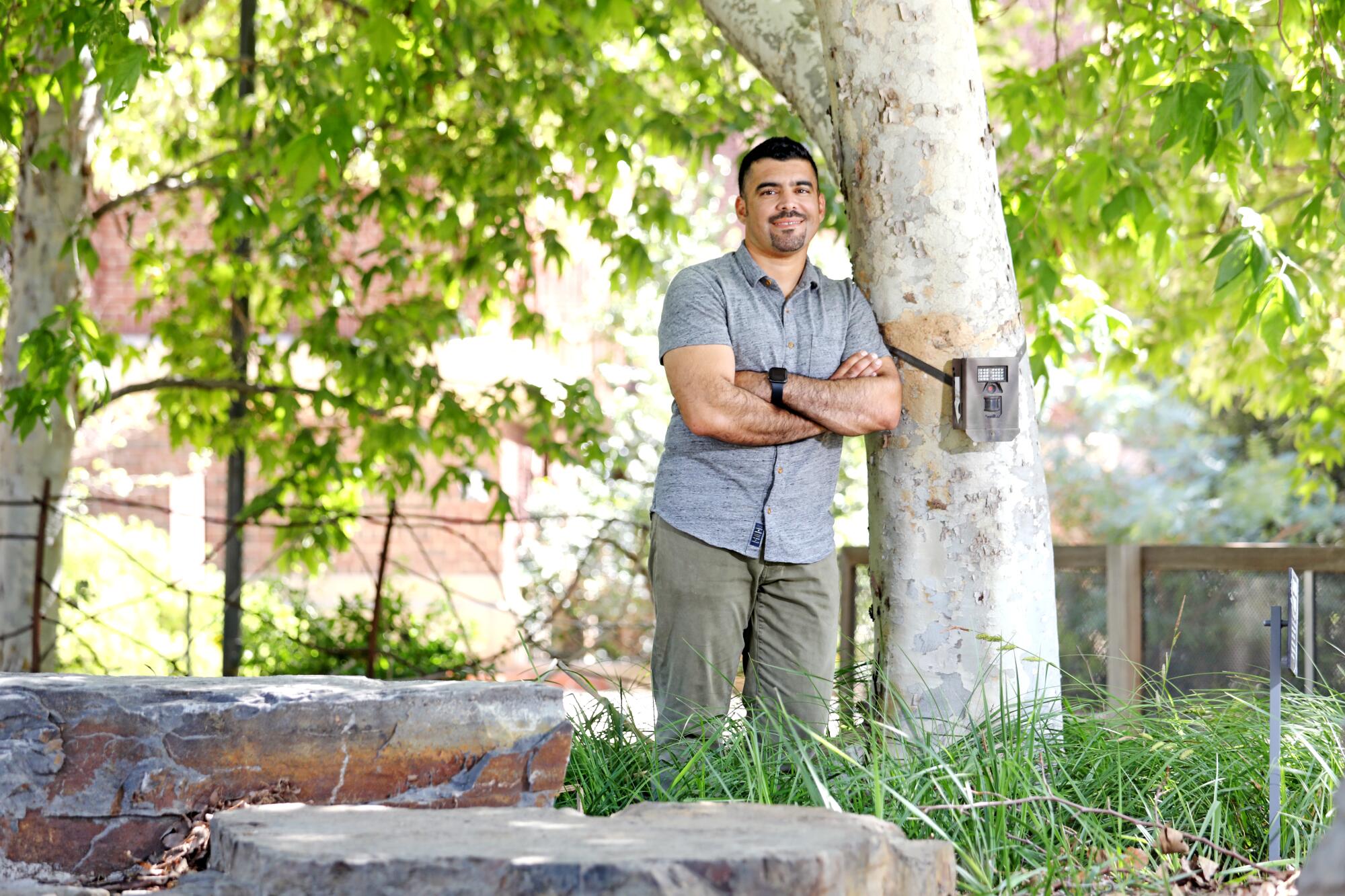
When the news reached the National Park Service, biologist Jeff Sikich was floored. He’d spent a decade studying the diets, movements and mating habits of pumas in the Santa Monica Mountains. But a mountain lion in Griffith Park?
Within weeks, Sikich and other biologists had trapped the puma, done a full physical exam and fastened on a lightweight radio tracking collar. The team gave him a name, too: P-22. (That’s P for puma, the 22nd in their study.)
Genetic testing showed that P-22’s father was P-1, who had previously killed other young pumas. Most male cougars tracked in the Santa Monica Mountains— facing a triple threat of freeway traffic, rat poison and other big cats — have not lived past the age of 2, roughly P-22’s age when he appeared in Griffith Park, Sikich said. His dramatic journey may have saved his life.
His already slim chances of finding a mate are getting slimmer as he ages. If P-22 tried to cross a freeway again, he probably wouldn’t survive. The NPS said that 26 cougars have been killed by drivers in the Santa Monica Mountains and surrounding area since 2002. An 18-month-old named P-97, who had recently left his mother and set out searching for his own territory, was found dead on the 405 early Thursday morning.
P-22’s life of solitude strikes a chord with Angelenos, but casting him as lovelorn or lonely isn’t exactly right, scientists say. Pumas are so retiring that they’re sometimes called “ghost cats,” and adult males carve out territories of up to 250 square miles. Male mountain lions don’t mate for life, either, embracing more of a “love ‘em and leave ‘em” lifestyle, Sikich said.
About two years after P-22 arrived in the park, the puma showed up on trail-camera footage looking gaunt, his tail as thin as a pipe cleaner. Sikich and other biologists trapped him, treated him with topical medications and vitamin K injections, and released him.

Subscribers get exclusive access to this story
We’re offering L.A. Times subscribers special access to our best journalism. Thank you for your support.
Explore more Subscriber Exclusive content.
Tests later confirmed that P-22 had been exposed to rat poison and was suffering from mange, a parasitic mite. At the time, only two other cougars in the study had contracted mange, and both eventually died. But P-22 made a full recovery.
Like many celebrities, his lowest moment became one of his most viral. The photo released of a sick P-22 looks a bit like a mugshot of an actor arrested for drunk driving: the once-handsome face frazzled, the eyes bleary and sagging. The image helped spur action in the California Legislature and ultimately led to a 2020 law temporarily banning some kinds of rat poison, Pratt said.

(Two six-week-old mountain lion kittens that died last year after being found in Thousand Oaks had three types of rodenticide in their systems, the National Park Service announced April 13.)
Months after P-22 was diagnosed with mange, a contractor for a home security firm discovered the cat reclining in the crawl space of a house in Los Feliz.
Within hours, the street was jammed with news vans, and helicopters hovered above the sleek white contemporary, covering the incident like an FBI raid. One chyron on a local news story screamed: “BREAKING NEWS: P-22 TRAPPED INSIDE HOME.”
Animal control officials tried to coax him, then scare him, out from under the house, launching beanbags and tennis balls and poking him with a stick. When they finally cleared the area and gave him space, P-22 slipped away unseen.
For humans, Southern California’s freeways link distant communities that are otherwise separated by rugged mountains, vast deserts and inland valleys.
Then, one morning in 2016, a 14-year-old koala named Killarney went missing from her enclosure at the Los Angeles Zoo. Zookeepers saw no sign of a struggle. The marsupial’s mutilated body was later found about 400 yards away.
The evidence pointing to Griffith Park’s resident mountain lion was circumstantial, but damning. The attack was not recorded, but the zoo’s surveillance cameras placed the puma at the scene. Few animals can clear an eight-foot fence topped with barbed wire. Even fewer have a taste for koala. (P-22 could not be reached for comment.)
After Killarney’s death, the zoo could have sought a permit to have P-22 killed. Instead, they took the mountain lion’s side.
“Of course, you go down the road of, ‘Why did you do that to Killarney?’” said Beth Schaefer, the zoo’s director of animal programs. “But we’re in Griffith Park, and Griffith Park is his home, and we have to respect that. You can’t hold a mountain lion accountable for being a mountain lion.”
Los Angeles’ most famous mountain lion was spotted roaming the streets of Silver Lake this week.
It was proof of one of the most unusual elements of P-22’s story: the city’s attitude toward him. Big cats prowl large swaths of the United States, but few other cities would allow a cougar to live in their midst for a decade, let alone embrace him, scientists say.
His quiet, dramatic presence in one of the country’s largest urban parks also has reshaped the way Angelenos think of their city. Despite its stereotype as a concrete wasteland, few large North American cities have as much biological diversity as Los Angeles.
“He symbolizes the wilderness that we have here in Los Angeles, and he reminds us of the possibilities, if we take care of it,” said Brenda Rees, who is on the executive board of Friends of Griffith Park.
P-22’s tracking collar records his location up to eight times per day: once during the day when he’s asleep, and then every two hours at night, when he’s active. The National Park Service does not generally release that data, hoping to protect P-22 from poachers and fans who could try to mob him.
But the big cat has learned the same hard truth as other intensely private celebrities: You can’t go out in Los Angeles these days without someone recording you.

His late-night patrols through Beachwood Canyon, the Cahuenga Pass and other hilly areas near the park once went largely unnoticed, but are increasingly captured by Ring and Nest doorbell cameras and shared on Facebook and Nextdoor.
He made the news again in March when he was recorded stalking down a sidewalk south of the Silver Lake Reservoir, the farthest he’s ever ventured into the urban core.
The National Park Service confirmed the 120-pound mountain lion’s radio collar was in Silver Lake on Tuesday night.
“He’s a cool cat,” said Layton Cutler, the head brewer at Angel City Brewery, which has a limited-edition hazy pale ale on draft named after the puma. “I hope he’s enjoying his life in Griffith Park, and that once in a while, he gets to go over to Silver Lake and enjoy some happy hours.”

On a Friday night in March, after a few glasses of orange wine, Corie Mattie walked outside to pick up a food delivery. Then she saw a pair of eyes blinking at her from the deck of her brother’s house in the Hollywood Hills, where she was dog-sitting.
She dashed back inside to get her phone. On the video she recorded, she speaks wonderingly into the darkness as a giant pair of eyes stares back at her: “Dude. Dude, you’re huge. Dude. You’re big as s—.”
The experience was “lifechanging,” said Mattie, a 32-year-old artist. She is now designing a P-22 mural for a wall at Hyperion Public, a bar in Silver Lake. The mural will include a QR code so people can learn about the plight of local cougars, 104 of which have been captured, marked and studied.
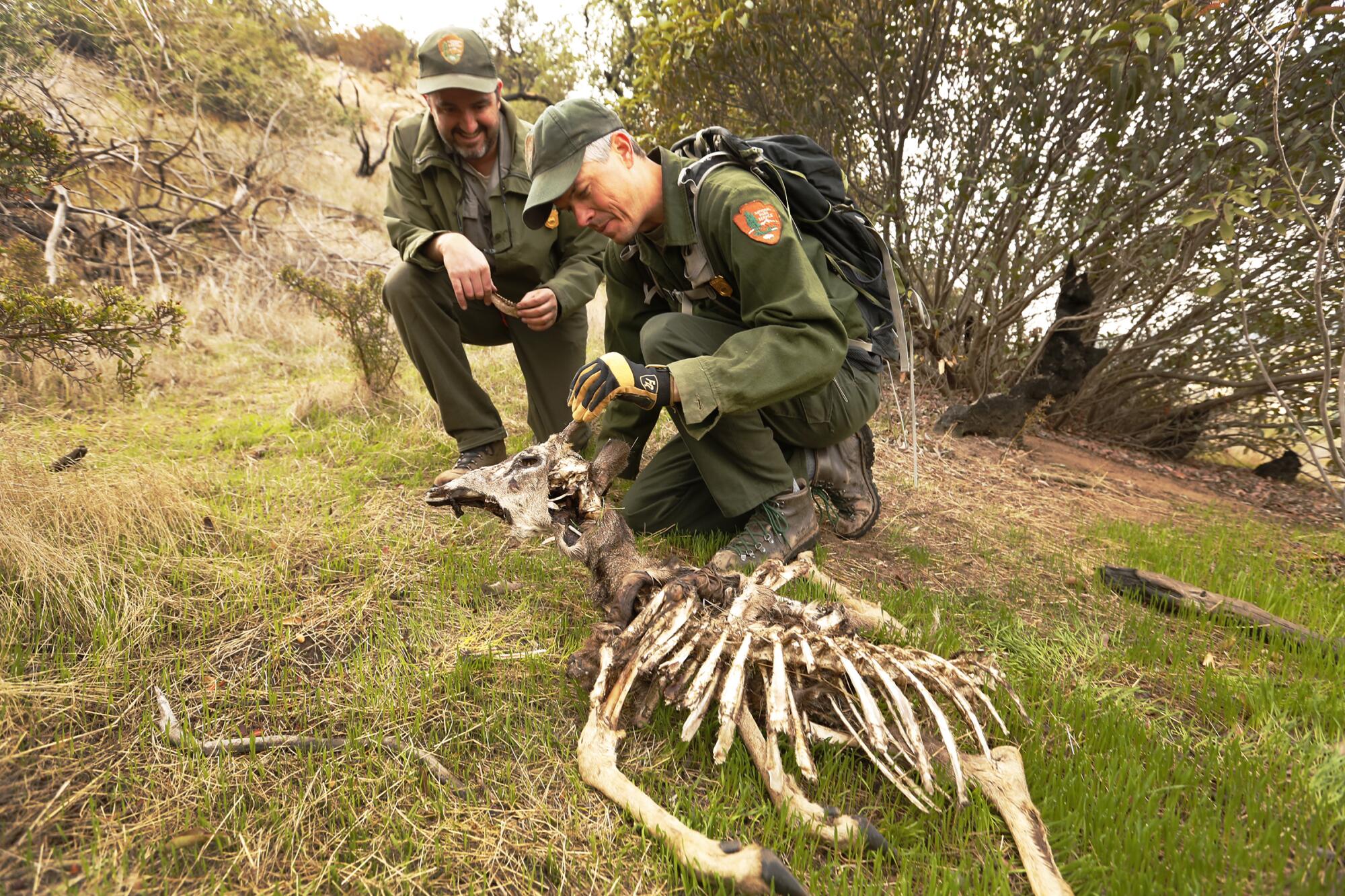
P-22 has become the poster cat for a conservation campaign called “Save L.A. Cougars,” aimed at helping his cousins in the Santa Monica Mountains.
The 101 Freeway forms an almost impenetrable barrier between the big cats and a wider gene pool to the north, which has led to inbreeding and genetic abnormalities. Recent scientific modeling has drawn a dire conclusion: Without intervention, pumas in the Santa Monica and Santa Ana mountains could be extinct within 50 years.
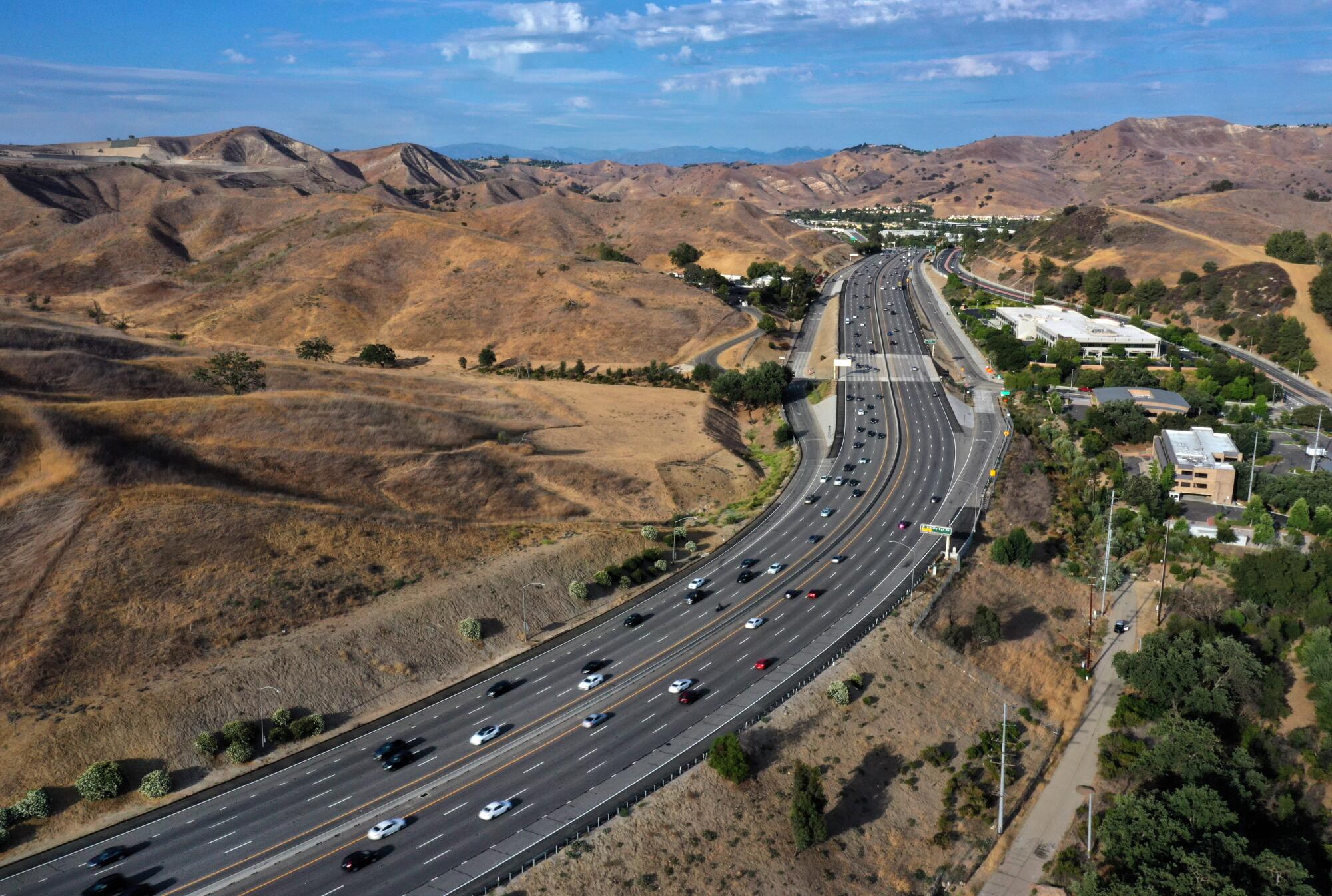
Southern California’s pumas are sometimes likened to the Florida panther, which teetered on the edge of extinction in the mid-1990s. The state had just a few dozen of the big cats left, and some had genetic abnormalities — including sterility — caused by inbreeding. Eight female cougars were eventually brought from Texas to help stabilize the gene pool.
California nature activists have spent more than a decade raising $77 million in private donations and state funding for a wildlife bridge across a 10-lane stretch of the 101 at Liberty Canyon, which they hope will avert a similar fate for L.A.’s pumas. The bridge won’t connect to Griffith Park, but P-22 was the face of a campaign that drew support from Leonardo DiCaprio’s foundation and people around the world. A retired couple from Kansas donated about $750,000.
Architect Robert Rock is designing a bridge over the 101 Freeway in Agoura Hills that will stop mountain lions from becoming roadkill.
The $90-million project breaks ground Friday and is slated to open in 2025.
“He’s changed the world for his kind,” Pratt said. “That’s not an overstatement. For me and for people across the world, we view wildlife and living with predators differently because of that cat. And he doesn’t know it. He’s just sitting there munching on deer in Griffith Park, not knowing.”
Unable to speak for himself, P-22 has spawned a ream of imitators on Twitter and Facebook. “All this talk about ‘Shark Week,’” one account snarked. “Whatevs. Call me when a shark moves into a huge park in the middle of a city.”
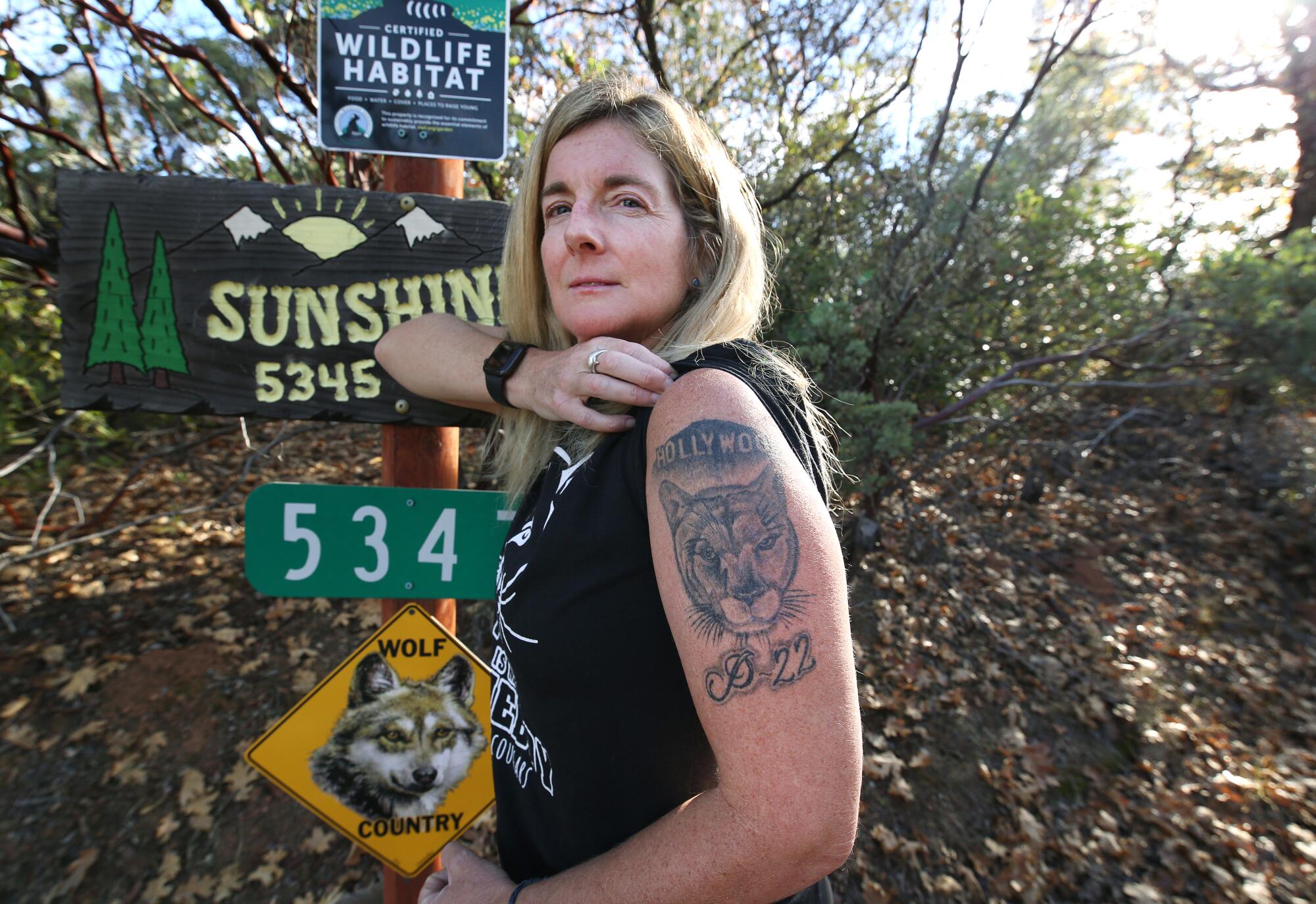
His Facebook page, run by Pratt, says: “Hi! I’m L.A.’s loneliest bachelor. I like to hang out under the Hollywood sign to try and pick up cougars.”
But after a decade of the kind of celebrity that most humans never attain, P-22 is living on borrowed time. Mountain lions in the wild don’t typically survive beyond 12 years, and he is thought to be 12 or 13.
P-22’s death is a painful thought for the community of scientists, advocates and armchair enthusiasts that has studied and protected him.
“We have our heads in the sand,” McMahan said. “We don’t want to think about it. Five years from now, when he’s no longer with us, am I going to have the same interest in going out and checking my cameras as I do now? Probably not.”
When P-22 does not move for more than 12 hours, his collar is designed to send Sikich a text message — a mortality signal of sorts. After a necropsy to determine the cause of death, Ordeñana hopes to have the cougar’s body taxidermied. He could be preserved in the Natural History Museum’s archives or put on display.
“I don’t want it to be this tourist attraction,” Ordeñana said. “But for some people, it would be a way to immortalize him.”
Not that he needs it.
More to Read
Start your day right
Sign up for Essential California for news, features and recommendations from the L.A. Times and beyond in your inbox six days a week.
You may occasionally receive promotional content from the Los Angeles Times.
